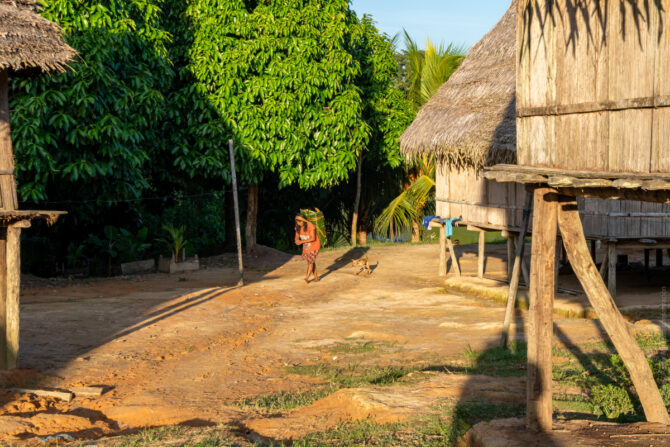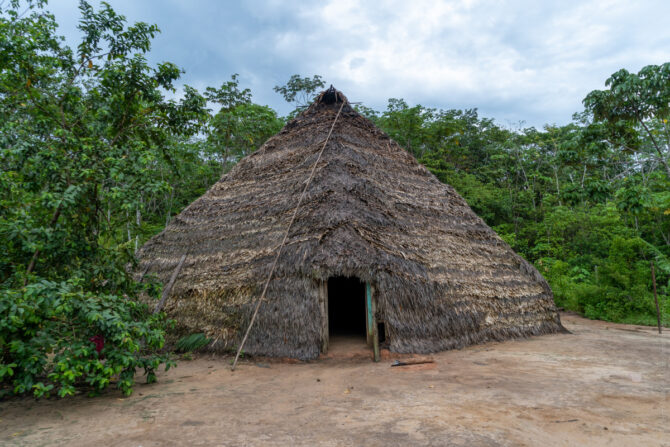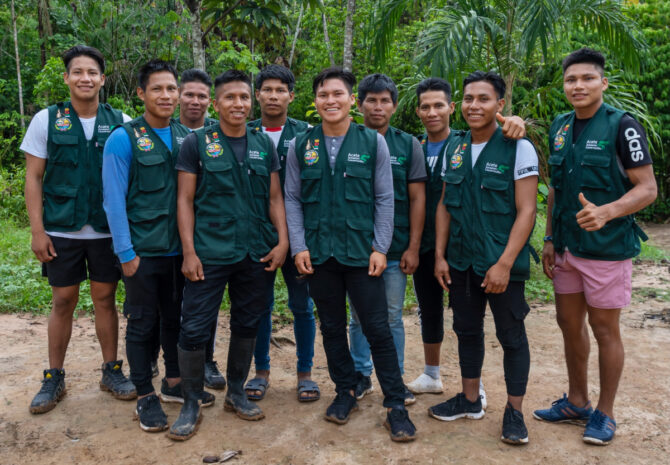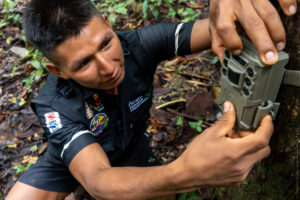
Community-based initiative in partnership with Acaté protects uncontacted tribal groups in isolation and endangered river turtles –
To reach the Matsés territory requires either a weeklong boat trip passing through Brazil; a flight on a small plane; or a multi-day walk through the jungle. This inaccessibility and the Matsés fierce reputation have been the major factors protecting this area historically. The Matsés communal territory is the key to a binational area of the Amazon Rainforest that includes the Matsés National Reserve, the Sierra del Divisor National Park, the Yavari Tapiche Indigenous Reserve and the Vale do Javari Reserve in Brazil (alone the size of Austria). Together this region is one of the largest and wildest areas left on our planet and the home of the highest number of people still living in voluntary isolation or uncontacted people. These people are at risk of life-threatening disease should they be contacted by adventure seekers, fanatical missionaries, misguided governmental operatives, or illegal resource extractors. The Matsés have had encounters with the uncontacted in their ancestral hunting grounds and there is the potential for conflict. In southern portions of the Peruvian Amazon there have been deadly conflicts when uncontacted bands raid isolated villages seeking metal tools and food stores. The movement patterns of the uncontacted groups that enter the Matsés Ancestral Territory are unclear but are likely linked to land use changes to the southeast in Brazil and to normal seasonal movements for hunting.
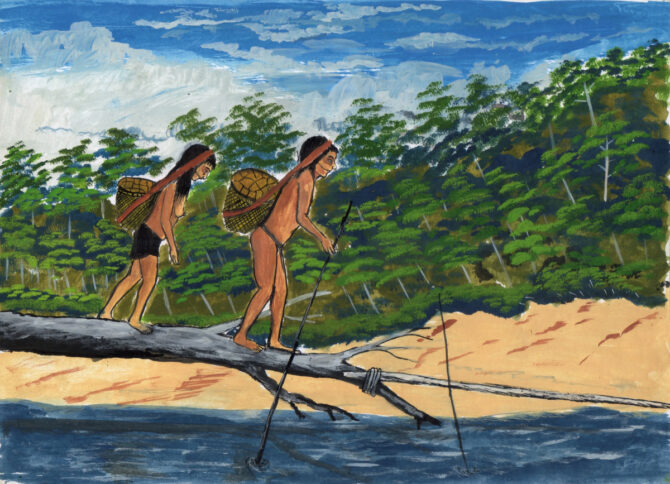
Isolated peoples crossing the Javari river: rendering by Matsés indigenous artist Guillermo Nëcca Pëmen Mënquë©Acaté
The potential for conflict remains if one of these bands should raid a Matsés camp looking for axes or other metal implements. The Yaquerana River (headwaters of the Javari River) is the international border between Peru and Brazil through part of Matsés territory. As such, it is not legal for the Matsés to close the river to boat traffic from the settler communities downriver in both Peru and Brazil. Poachers take advantage of this to enter the territory for commercial fishing, endangered turtle egg collecting, and timber cutting. The threat of construction of a road from the Ucayali to the Javari makes this work even more urgent. The road will bring a wave of settlers looking for new land to exploit along with the timber mafias who will use the road to exploit previously inaccessible highly valuable timber species like Spanish Cedar and Mahogany.
In early 2021 Acaté was approached by a Matsés youth association based in the Matsés community of Puerto Alegre, the southernmost village on the Yaquerana River and gateway to the remote headwaters. This youth association is called Iscu, the Matsés term for oropendolas, birds that live in large colonies and weave hanging nests; their calls are an emblematic sound of the Amazon. The Iscu association wanted to create a conservation area, protect the people in voluntary isolation through creation of a monitored buffer zone between areas of Matsés inhabitation and areas where there are uncontacted groups living in isolation, and start a conservation program for endangered river turtles. As Acaté is the only NGO that carries out on-the-ground projects in Matsés territory and has a long track record of successful projects, we were the logical partner for this initiative.
There, in partnership with the people of Puerto Alegre and the Iscu Association, we made a plan to strengthen protection of the uncontacted people with support and coordination of the Junta Directiva, the elected Matsés leaders. 
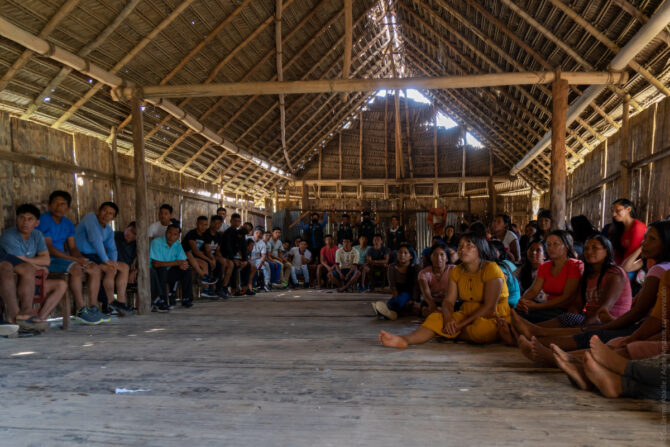 Everyone was in agreement that the idea was not to look for or to make any attempt to contact them but to patrol the southern edge of the Matsés Ancestral Territory for outsider incursions into the area, from timber cutters, frontier settlers, hunters, or adventure tourists. The Matsés would take appropriate measures to avoid conflicts with them while shielding them from encroachment.
Everyone was in agreement that the idea was not to look for or to make any attempt to contact them but to patrol the southern edge of the Matsés Ancestral Territory for outsider incursions into the area, from timber cutters, frontier settlers, hunters, or adventure tourists. The Matsés would take appropriate measures to avoid conflicts with them while shielding them from encroachment.
Creation of an Observation Post and Initiation of Patrols
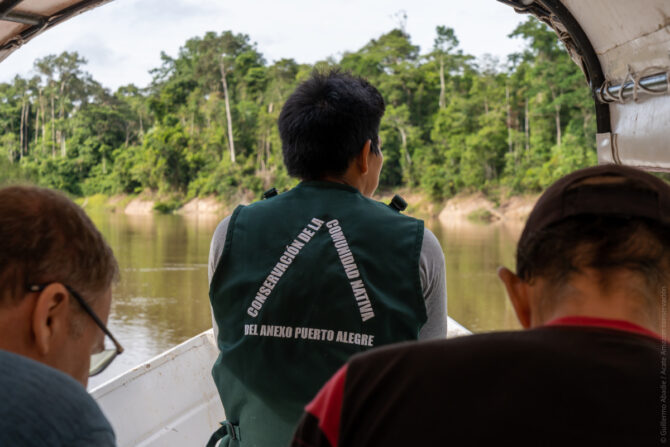
To realize this project the Iscu members built an observation up-river from the village with support from Acaté. They built two small structures, both on stilts, on the river bank, with local materials. The observation post is on a high point of the river bank and near a straighter section of the river for maximum visibility in both directions. This guard post allows the Matsés to monitor a key area of the Yaquerana as a base of operations for the patrols.
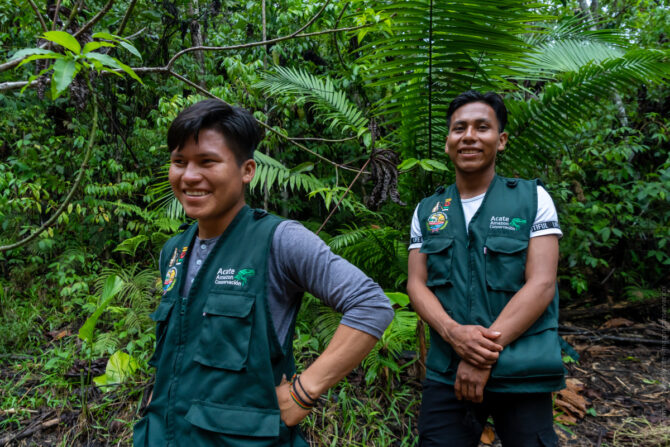 The presence of the post also discourages poachers. Acaté provided a short-wave radio so they could communicate over all the Matsés territory and to the settler community of Angamos if necessary. We also provided them with a motor, flashlights, camera trap, boots, machetes, fuel, vests, and food supplies for the patrols. The Matsés would look for signs of uncontacted such as footprints (barefoot) and for broken stems in the understory. Typically, when younger Matsés or mestizos walk off trail in the forest they cut understory plants to mark a trail for the way back with a machete. An elder Matsés or an uncontacted person would just bend the plants over to mark their trail. The other way that the Matsés have noted the presence of uncontacted peoples in isolation without direct visual contact have been through hearing vocalizations, such as calls for hunting monkeys. Like the Matsés, they mimic the monkey’s vocalizations when hunting, hoping to draw the monkeys close enough for a shot with bow and arrow. The Matsés can tell the difference between a real spider monkey call or whinnie and that of a human mimic.
The presence of the post also discourages poachers. Acaté provided a short-wave radio so they could communicate over all the Matsés territory and to the settler community of Angamos if necessary. We also provided them with a motor, flashlights, camera trap, boots, machetes, fuel, vests, and food supplies for the patrols. The Matsés would look for signs of uncontacted such as footprints (barefoot) and for broken stems in the understory. Typically, when younger Matsés or mestizos walk off trail in the forest they cut understory plants to mark a trail for the way back with a machete. An elder Matsés or an uncontacted person would just bend the plants over to mark their trail. The other way that the Matsés have noted the presence of uncontacted peoples in isolation without direct visual contact have been through hearing vocalizations, such as calls for hunting monkeys. Like the Matsés, they mimic the monkey’s vocalizations when hunting, hoping to draw the monkeys close enough for a shot with bow and arrow. The Matsés can tell the difference between a real spider monkey call or whinnie and that of a human mimic.
Deployment of Camera Traps to Monitor Area
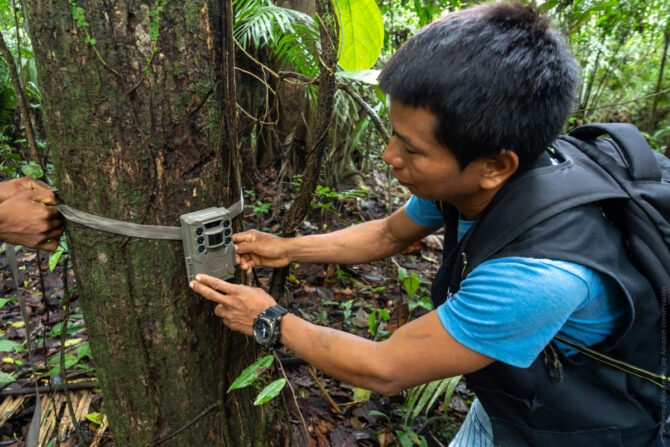 The patrols consisted of three or four person teams and lasted for one week each. The patrols have also deployed a camera trap near areas with high densities of animals, mineral deposits where peccaries wallow and there are higher densities of animals.
The patrols consisted of three or four person teams and lasted for one week each. The patrols have also deployed a camera trap near areas with high densities of animals, mineral deposits where peccaries wallow and there are higher densities of animals.
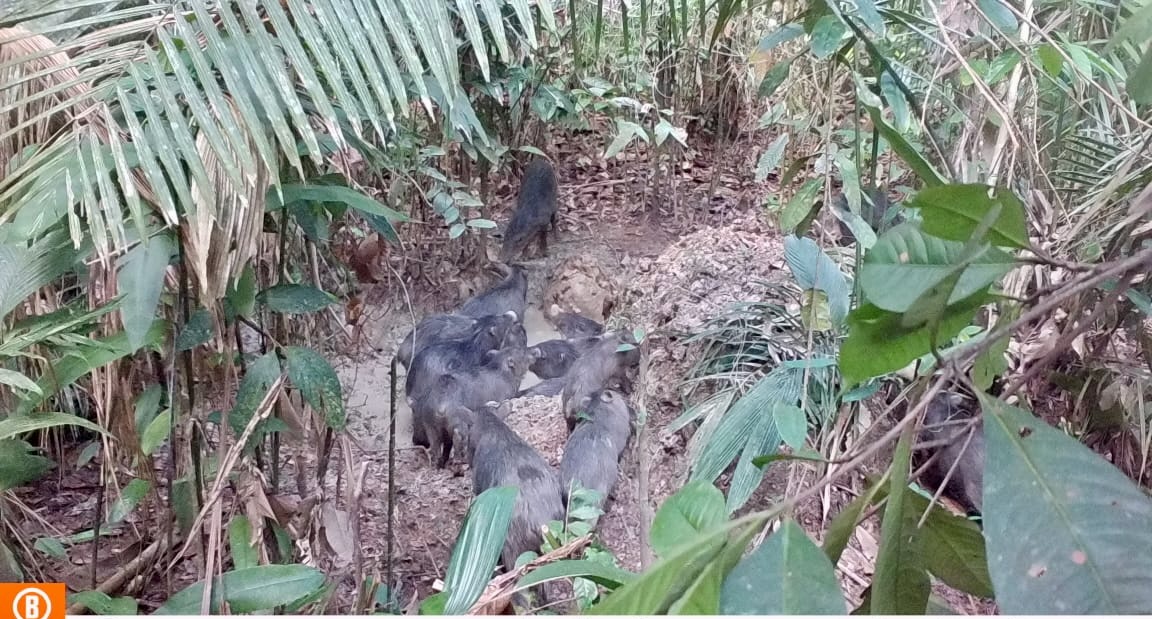
To date, six patrols have been carried out over the two years of the project with support from Acaté. If anyone was able to pass unnoticed upriver they would have to travel by boat. The patrols look for boats on the river banks. Poachers would be wary of being discovered so they would go up a smaller stream and attempt to hide their boat in the vegetation. The patrols being aware of this check the likely areas where a boat might be hidden. To date, no intruders have been found. During one patrol in December 2021, the group found a trail marked by bent over vegetation and found a barefoot print. This is not definitive proof of uncontacted people entering the Matsés territory but is another data point adding to other data points demonstrating the importance of this project. Upon this discovery they withdrew from the area to make sure they did not have an encounter.
Acaté provided the supplies for an expedition to demarcate the area and produce a map. Demarcating the areas away from the river required a weeklong overland trek. The capacity to survey and generate their own maps was previously acquired through the Matsés Indigenous Mapping Initiative in which the Matsés mapped, for the first time, their ancestral territories in Peru. In this landmark initiative supported by Acaté, the Matsés mapped over a period of five years thousands of culturally important mapping points including locations of ancestral longhouses, sites of frontier skirmishes with Peruvian soldiers and areas of ecological importance as well as all of the waterways in their territory were recorded for the first time with their original Matsés names.

Before the start of the Matsés Indigenous Mapping Initiative, the Matsés rich knowledge of their lands and ancestral history resided only in the memory of their living elders. ©Acaté
The Protection of Isolated Peoples project is a on-the-ground community-based initiative supported by Acaté and is not associated with the Javari-Tapiche Corridor concept that is presently being advanced by the Peruvian Ministry of Culture. The Javari-Tapiche Corridor and other reserves to protect peoples in isolation created by the Peruvian Government have been challenged in regional districts through introduction of legislation backed by extractive industries. The fate of these plans is uncertain. In any eventuality and path forward, the success of these reserves will depend on on-the-ground conservation efforts, such as of those described herein this field report, led by the communities most invested to ensure the integrity of these highly sensitive areas for conservation and to protect the self-determination of isolated groups. In our April 2022 meeting with the Matsés leadership attended by the entire Acaté team we carefully reviewed the work that had been done and laid out the plans and vision for the next steps for the project.
Threatened River Turtle Project
For the Matsés, one of the important goals of the projects is to set-aside a wilderness conservation area zone. Riverine turtles play a vital role in the ecology and their eggs are an important indigenous traditional food throughout the Amazon region. They are now threatened with extirpation due to over collecting of eggs from their nesting beaches and the hunting of adult turtles. The largest turtle in the Amazon, known locally as Charapas (Podocnemis expansa), which can weigh up to 200 pounds, is facing extirpation in Peru because the large adults are easily hunted and the eggs are large and highly sought after.
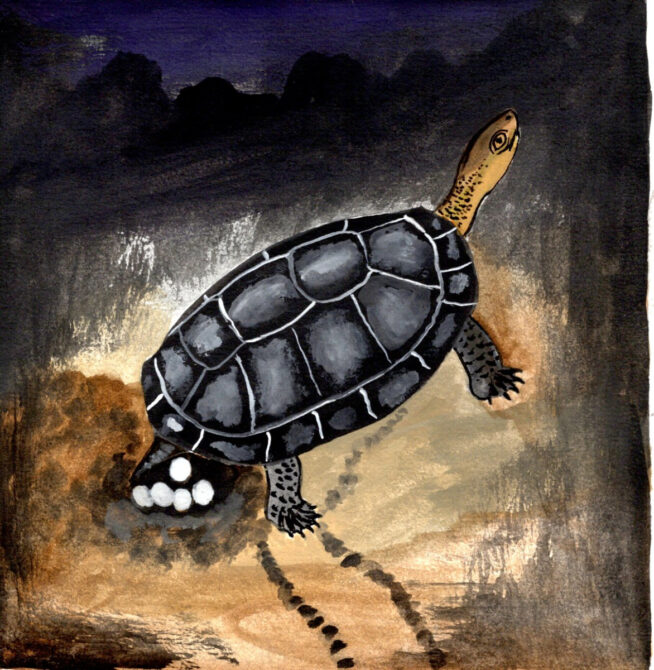
Charapa (Podocnemis expansa) rendering by Matsés indigenous artist Guillermo Nëcca Pëmen Mënquë©Acaté
For the Matsés as well as frontier settlers, the eggs from both the Charapa and the smaller Taricaya (Podocnemis unifilis) are an important source of protein and calories. Unfortunately, there are now stretches of the Yaquerana river where the turtle nests are no longer found due to commercial egg poaching. It is important to emphasize that the lack of controls on the egg trade will eventually lead the poachers further up river. Egg collecting can not be seen in isolation as the poachers will also hunt for bush meat and potentially cut timbers. Without an intervention these activities will spread up the river further endangering those uncontacted groups in voluntary isolation.
In October 2021 Acaté Peru team members David Fleck and William Park visited Puerto Alegre at their invitation to see the project’s progress. The first thing we noticed was that the Matsés had built a large structure near their port, above the river high water mark but still close enough to hear any passing motors. This building functions as the project headquarters and storage area for equipment. The Matsés in Puerto Alegre agreed to set aside a portion of the Yaquerana River beaches as a turtle conservation area. This is very important as in general conservation projects fail due to the lack of engagement with the local communities. In this case the Matsés took the initiative to learn how to successfully hatch turtle eggs and gained some cooperation from the other Matsés communities who collect turtle eggs during the low water nesting season. Thanks to the IIAP (Instituto de Investigaciones de la Amazonía Peruana) there were Matsés in Puerto Alegre who had received in years past training in the complex process of turtle conservation. The first step is going out to the nesting beaches and collecting the eggs. This must be done very carefully because if the egg’s orientation is changed the embryos are less likely to successfully hatch. 
 The eggs were carefully loaded into buckets with sand to avoid any rotation or movement of the eggs. The team had built a series of artificial beaches in the community, where the eggs were placed. This requires great care in making sure the artificial nest has an air pocket and is close enough to a natural nest to ensure survival. When the eggs hatch, after around two months, the hatchlings are then moved to temporary pools, made with tarps, to grow and get stronger. Then they are relocated to a larger artificial pond where they are fed with aquatic plants until they are big and fast enough to increase their survival rate when reintroduced to the river, another month. Acaté supplied equipment for the collection of turtle eggs and for the construction of a turtle egg hatchery as well as fuel, food supplies, boots, and vests. When the patrols collect the turtle eggs before the poachers it discourages poaching as the poachers come back empty-handed. In the 2021 season 7000 turtle eggs were collected with a 90% survival rate. We are especially pleased that the rarer giant river turtle eggs were also collected bringing hope for the restoration of these turtles in the area. The patrols are also removing turtle traps and freeing the turtles they find trapped. During our meeting with the community we planned for the 2022 season. For 2022 we again supplied all the equipment that they needed for the project and they successfully collected 11,000 eggs!
The eggs were carefully loaded into buckets with sand to avoid any rotation or movement of the eggs. The team had built a series of artificial beaches in the community, where the eggs were placed. This requires great care in making sure the artificial nest has an air pocket and is close enough to a natural nest to ensure survival. When the eggs hatch, after around two months, the hatchlings are then moved to temporary pools, made with tarps, to grow and get stronger. Then they are relocated to a larger artificial pond where they are fed with aquatic plants until they are big and fast enough to increase their survival rate when reintroduced to the river, another month. Acaté supplied equipment for the collection of turtle eggs and for the construction of a turtle egg hatchery as well as fuel, food supplies, boots, and vests. When the patrols collect the turtle eggs before the poachers it discourages poaching as the poachers come back empty-handed. In the 2021 season 7000 turtle eggs were collected with a 90% survival rate. We are especially pleased that the rarer giant river turtle eggs were also collected bringing hope for the restoration of these turtles in the area. The patrols are also removing turtle traps and freeing the turtles they find trapped. During our meeting with the community we planned for the 2022 season. For 2022 we again supplied all the equipment that they needed for the project and they successfully collected 11,000 eggs!
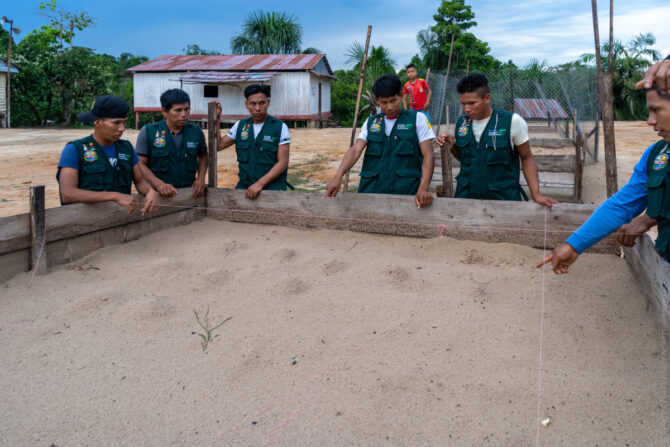

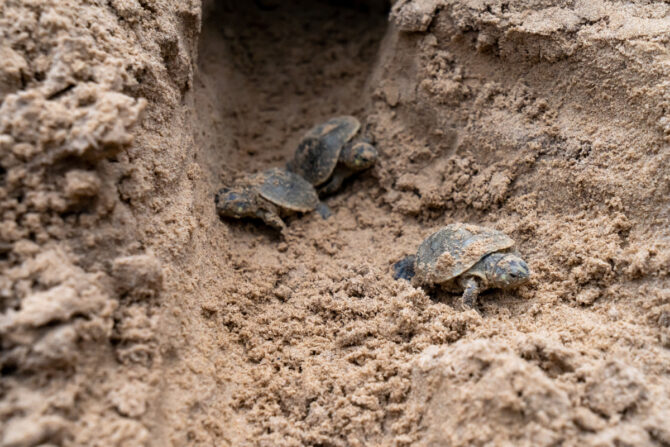
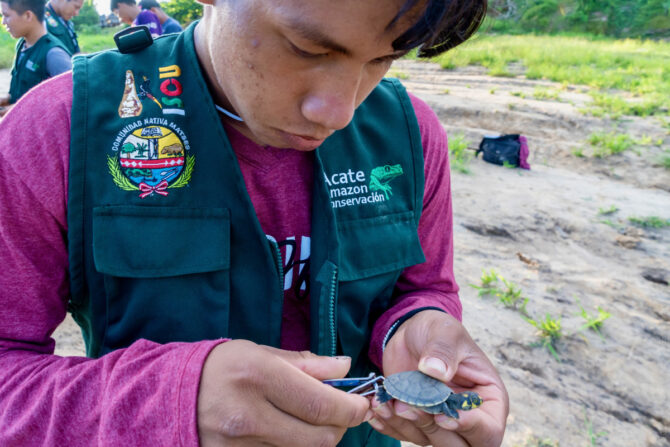
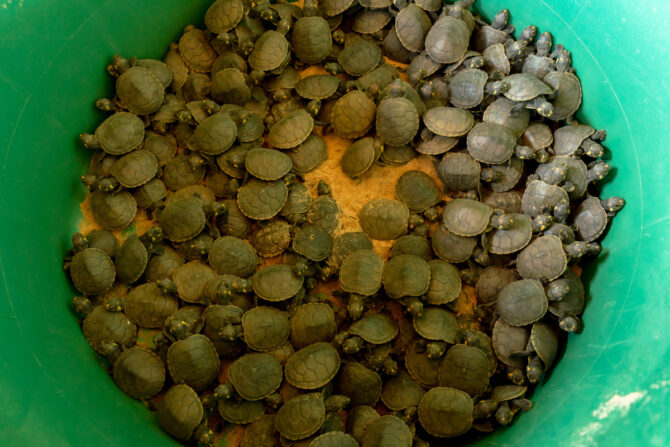
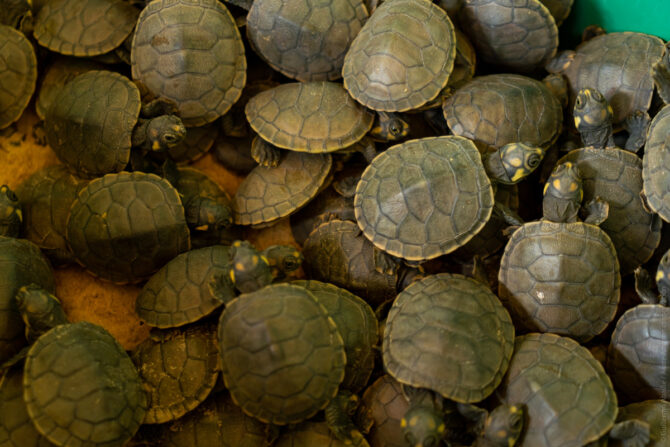
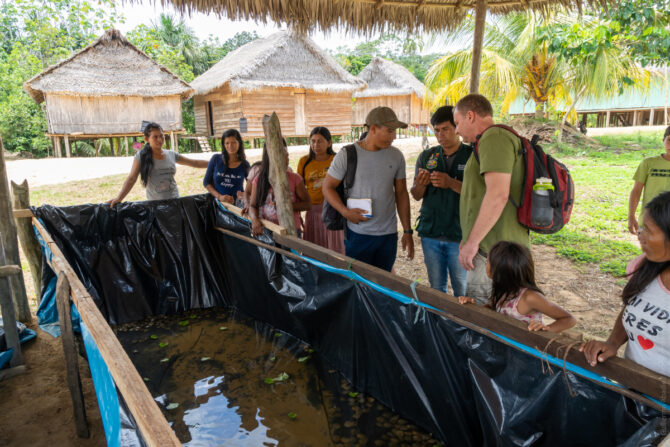

Additional Matsés villages, including two across the river in adjacent Brazil, want to participate in the project and have a vision of restoring the precontact turtle populations. The community members in Puerto Alegre see the turtle project as part of their larger vision to conserve the forests around Puerto Alegre. They want to create a community conservation area. This area includes the turtle nesting beaches and a large area of forest. Their plan is to create areas where cutting timbers is prohibited and to allow game animal populations to recover.
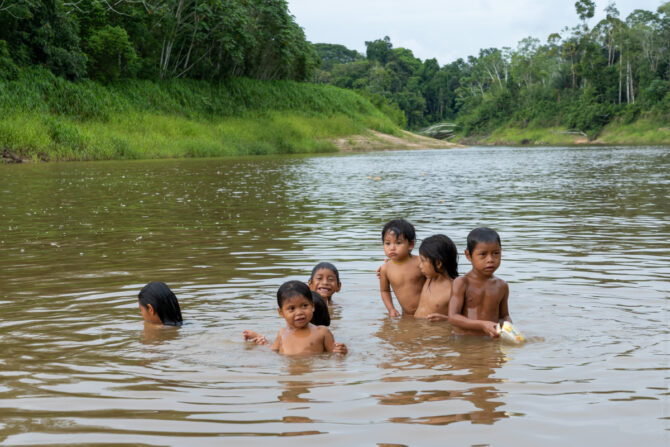
On behalf of our organization and indigenous partners, we express our deep gratitude to our supporters for their partnership and generosity which permitted the Matsés to realize their vision of strengthening protection and stewardship for this critical conservation corridor.
Stay tuned for further updates on our Indigenous Leadership and Governance Initiative as well as very exciting news on the revitalization of the Matsés youth association Caniabo with the support of Acaté. If you missed it, take a look at our April 2022 field report with the latest update from our ongoing initiative with the Matsés to support bilingual education and intergenerational transfer of ecological knowledge. In this update Dr. David Fleck reports on the development of three new interactive cellular phone apps as well as the latest publication addition to Acaté’s bilingual ecological readers collection!

Acaté Amazon Conservation is a non-profit organization based in the United States and Perú that operates in a true and transparent partnership with the Matsés people of the Peruvian Amazon to maintain their self-sufficiency and way of life. The Matsés safeguard a critical conservation corridor and shield some of the last remaining uncontacted tribes in isolation from unwanted encroachment from the outside world. Acaté works to protect their forests and way of life through supporting on-the-ground initiatives that are led by the Matsés indigenous people.
Operating on the frontlines of conservation, Acaté’s initiatives over the past decade have included the first indigenous medicine encyclopedia as well as projects with original methodology in sustainable economic development, traditional medicine, medicinal agroforestry, nutritional diversity, regenerative agriculture, biodiversity inventory, education, native language literacy, participatory mapping, and protection of uncontacted tribal groups in isolation. All of our initiatives are developed with, led and implemented by the Matsés indigenous people. Donations are tax-deductible and go directly to fund these on-the-ground initiatives that operate with unparalleled transparency.
All content and images copyright 2023 Acaté
